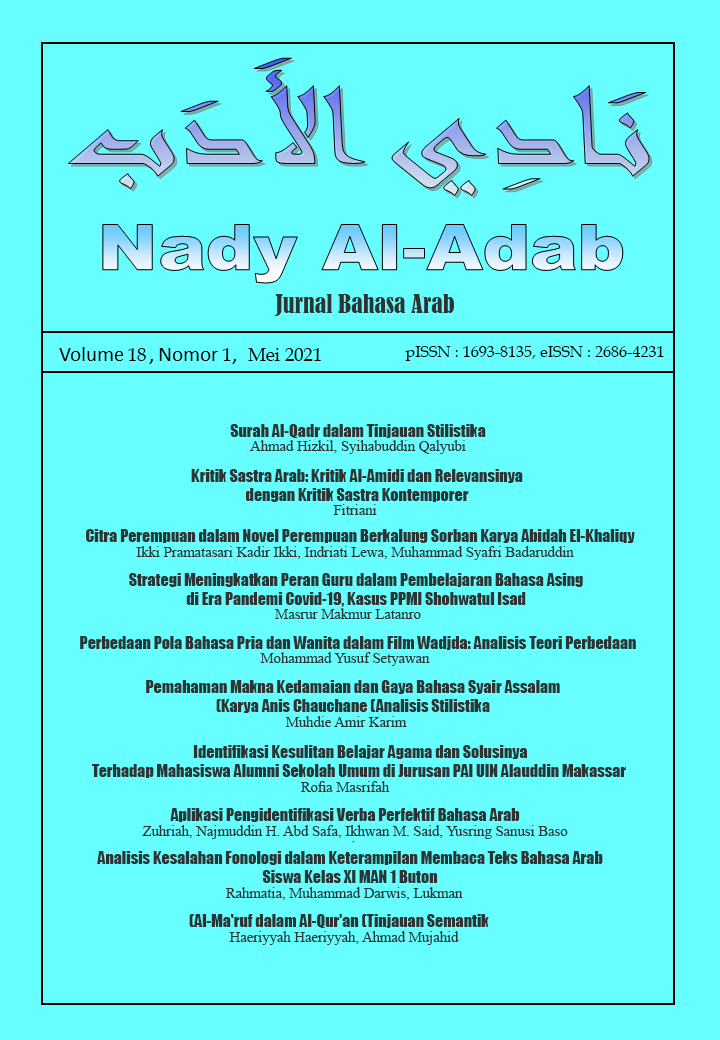APLIKASI PENGIDENTIFIKASI VERBA PERFEKTIF BAHASA ARAB
DOI:
https://doi.org/10.20956/jna.v18i1.18233Abstract
This article describes the application of grammar rules in computation system with the object of study ofArabic perfect verbs. The application of grammar rules in a system is very significant to do because thestatistic model used in the previous application has not given a good result yet. A system must havegrammar rules in identifying each verb-forming component in order to achieve a precise and accurateresult. Therefore, this application used tagmemic grammar in identifying Arabic perfect verbs .The method used was mixed methods as this research is based on research and development (R and D) –research used to produce a specific product and to examine the effectiveness of the product. Thismethod began with needs analysis and literature review related to grammar, theory implementation,application planning, product evaluation, validation and dissemination .The result showed that the system has been able to identify perfect verbs in a sentence based on its signs.In addition, the system has also been able to elaborate the verbs into core tagmeme and outer coretagmeme based on tagmemic theory .Downloads
References
Abu-Chacra, F. (2007). Arabic An Essential Grammar. New York: Routledge.
Agussalim, A. (2018). "Pengembangan Piranti Lunak Penerjemahan dari Bahasa Makassar ke
Bahasa Indonesisa Berbasis Tata Bahasa". Disertasi. Makassar:Universitas Hasanuddin.
al-Dahdah, A. (1995). Mu'jam Tasrif al-Af'al al-Arabiyyah. Bayrut: Maktabah Lubnan.
al-Hamid, M. M. (1951). Syarh Ibn Aqil (Vol. 1). Mesir:al-Sa'adah.
al-Jarim, A., & Amin, M. (1999). al-Nahw al-Wadih fi Qawaid al-Lughah al-Arabiyyah (Vol.
. t.tp:Dar al-Ma'rif.
Alwasilah, A. C. (1985). Beberapa Madhab dan Dikotomi Teori Linguistik. Bandung:Angkasa.
Baso, Y. S. (2016). Model Pembelajaran bahasa Arab Online Berbasis Learning Management
System. Makassar:Program Studi Sastra Arab Universitas Hasanuddin.
Borg, H. R., & Gall, M. (1989). Educational Research an Introduction Fifth Edition. New
York:Longman.
Chaer, A. (1994). Linguistik Umum. Jakarta:Rineka Cipta.
Darwis, M. (2012). Morfologi Bahasa Indonesia Bidang Verba. Makassar: CV. Menara Intan.
Hasan, T. (1979). al-Lughah al- 'Arabiyyah Ma'naha wa Mabnaha. t.tp.: t.p.
Hidayatullah, M. S. (2017). Cakrawala Linguistik Arab. Jakarta:PT Grasindo.
Kridalaksana, H. (2001). Kamus Linguistik. Jakarta:PT Gramedia Pustaka.
Mas'udi, G. A. (1992). Sejarah Islam dari Awal hingga Runtuhnya Dinasti Usmani:Tarikh Pra
Modern. Jakarta:Raja Grafindo Persada.
Mustafa, M. S. (Tanpa Tahun). al-Nahw al-Wasfy min Khilal al-Qur'an al-Karim.
Kairo:Mu'assasah 'ala Jazah al-Sabah.
Nasution, S. (2017). Pengantar Linguistik Bahasa Arab. Sidoarjo:CV Lisan Arabi.
Ralph, G. (1986). Computational Linguistics. New York:Cambridge University Press.
Ramlan. (1987). Morfologi Suatu Tinjauan Deskriptif. Yogyakarta:CV Karyono.
Samsuri. (1987). Analisis Bahasa. Jakarta:Erlangga.
Soeparno. (2008). Aliran Tagmemik; Teori, Analisis dan Penerapannya dalam Pembelajaran
Bahasa. Yogyakarta:Tiara Wacana.
Suarga. (2012). Algoritma dan Pemrograman. Yogyakarta:Andi.
Sugiono. (2009). Metode Penelitian Kuantitatif Kualitatif dan R&D. Bandung:Alfabeta.
Suprapto. (2008). Bahasa Pemrograman. Departemen Pendidikan Nasional.
Suyanto. (2010). Artificial Intelligence. Jakarta:Informatika.
Tarigan, H. G. (2009). Pengajaran Tata Bahasa Tagmemik. Bandung:Angkasa.
Tu'aimah, R. A. (1989). Ta'lim al-'Arabiyyah ligayr al-Natiqin biha: Manahijun wa Asalibuh.
Maroko:ISESCO.
Verhaar, J. (1998). Pengantar Linguistik. Yogyakarta:Gadjah Mada University Pres.
Downloads
Published
How to Cite
Issue
Section
License

This work is licensed under a Creative Commons Attribution-NonCommercial 4.0 International License.
All right reserved. The articles in this journal are under copyright of journal Nady al-Adab and the author of the article. No part of the articles may be reproduced without permission of the journal management



















